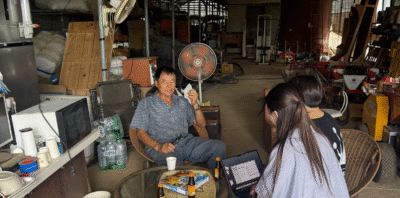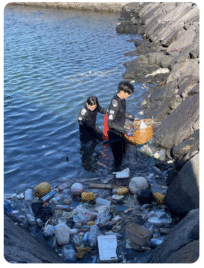Revealing the Hidden Story of the Streets
A Different Side of Sinsa-dong
On August 18, 2025, our Spiritus team headed to Sinsa-dong in Gangnam, a neighborhood known for its fashionable streets, cozy cafés, and endless streams of visitors. At first glance, the area sparkled with life. But as we left the main road and entered the smaller backstreets, another side of Sinsa revealed itself. Crumpled cups hid in corners, plastic bottles lay under benches, and snack wrappers drifted between parked scooters.
We didn’t come just to make the streets look nice for a day. Our purpose was deeper — to understand the hidden waste around us, where it collects, what it consists of, and what it reveals about everyday habits. We wanted to clean, observe, and learn.

Discovering the Hidden Layers
Each of us took a different route through the neighborhood. While the main road was relatively clean, the narrow alleys and service paths told another story. Behind a row of busy cafés, we found piles of paper cups — some still half-full — tucked between overflowing recycling bins.
Near delivery motorbike stands, snack packaging and drink cans were scattered like confetti from a celebration no one had cleaned up. In quiet parking lots, cigarette butts had collected in little grey clusters, and even beneath street-side flower planters, plastic straws and food wrappers had gathered.
Each discovery felt like peeling back a new layer of the neighborhood, exposing parts of it that most people overlook as they walk past with coffee cups or shopping bags in hand.
The Stories Behind the Waste
Every piece of trash told a small story. The crushed energy drink can near a convenience store likely belonged to someone rushing between errands. The greasy takeout container by a back door might have been tossed after a late kitchen shift. The pile of straws and cup sleeves under a bench hinted at office workers taking a short break in the shade.
These moments made us realize that litter is more than just a mess. It’s a record of human activity — of how people move, eat, rest, and interact with their surroundings. Understanding those stories is the first step in imagining how we can prevent future waste.

A Team Effort with Shared Purpose
Cleaning the streets was hard work, but it never felt like a burden because we did it together. One person would spot a bottle hidden under a bush, and another would reach in to pick it up. Someone else sorted the trash as we went, making the process more efficient. We even created a small challenge to see who could find the most unusual piece of litter — the winner was a surprisingly intact party hat found near a construction site.
There were quieter moments too, like pausing to share water under the shade or looking back at a street we had just cleaned. These small breaks reminded us of why we were there: not only to tidy up, but also to care for a shared space.
Looking Ahead: Changing the Story of the Street

By the time we finished, the streets looked brighter, and even the air seemed lighter. But more important than the visible difference was the deeper understanding we gained. We now know Sinsa-dong’s hidden corners, its habits, and the patterns of its waste.
Our next step is to keep showing up. Each cleanup will make the neighborhood a little cleaner, and each walk will bring us closer to solutions that stop waste before it starts. In the end, our mission is not only about picking up what’s been left behind. It’s about changing the story of the street — one small act, one piece of litter, and one shared effort at a time.
Discover more from Spiritus Blog
Subscribe to get the latest posts sent to your email.



o4ge0d
o4ge0d